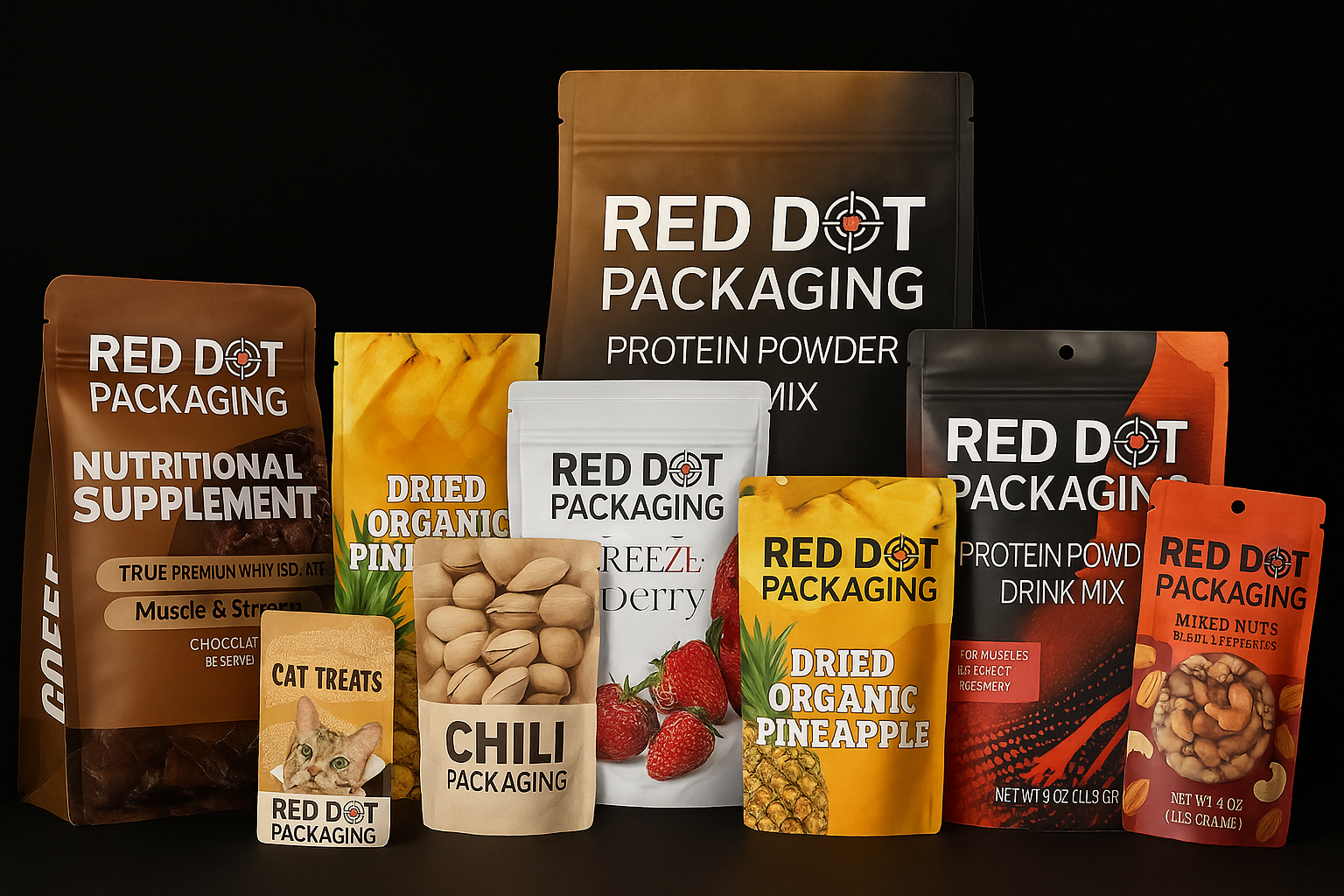Choosing the Right Custom Food Packaging
Learn how to choose food packaging that protects, sells, and sustains. Explore formats, materials, features, and solutions with Red Dot Packaging.

Choosing the Right Food Packaging for Your Product Line
Packaging does far more than just hold a product—it’s a critical factor in a brand’s success. The right food packaging protects your product, attracts buyers, communicates your brand story, and ensures compliance with safety standards. It’s the first impression a customer has and often the reason they choose your product over another.
Effective food packaging enhances shelf life by providing a barrier against moisture, oxygen, and contaminants, preserving freshness and flavor. It plays a key role in branding, turning ordinary shelf space into a visual showcase for your identity, values, and product quality. Regulatory compliance is also vital; packaging must meet food safety standards and may require specific features like child resistance or tamper evidence. Finally, the customer experience—from ease of opening to resealability and portion control—can build brand loyalty or drive customers away.
Choosing the right packaging is a strategic decision that blends functionality, aesthetics, sustainability, and market demands. In this guide, we’ll explore how to select packaging that supports your product, delights your customers, and helps your brand stand out.
Understand Your Product
Before choosing any food packaging, it’s essential to thoroughly understand the nature of your product. Packaging needs to be tailored to what you're selling to ensure performance, safety, and customer satisfaction.
1. Product Type
Different foods demand different packaging solutions:
- Dry goods like snacks, granola, or pasta typically require moisture barriers and strong seals.
- Wet or liquid products such as sauces, soups, or beverages need leak-proof structures and often benefit from spouted pouches.
- Frozen items require materials that can withstand freezing temperatures without becoming brittle or compromising seals.
- Oily or fatty foods like nuts or jerky may need grease-resistant barriers to prevent staining and preserve flavor.
- Powdered products like protein powders or spices benefit from features like powder-proof zippers and anti-static materials.
Identifying the physical and chemical properties of your product ensures you choose materials and features that maintain freshness, integrity, and shelf appeal.
2. Sensitivity to Environmental Factors
Products can be vulnerable to moisture, oxygen, light, or temperature changes:
- Moisture-sensitive foods (e.g., dehydrated fruit, crackers) require high-barrier laminations to stay crisp and dry.
- Oxygen-sensitive items (e.g., coffee, jerky) benefit from oxygen barrier films or degassing valves.
- Light-sensitive products (e.g., certain oils, supplements) may need opaque materials like foil or MET-PET to prevent degradation.
- Temperature-sensitive foods may call for insulated layers or packaging that can handle freezing or reheating.
Understanding these sensitivities helps in selecting materials with the right barrier properties to extend shelf life and maintain product quality.
3. Portion Size and Serving Frequency
How the product is used influences packaging format and features:
- Single-serve options are perfect for grab-and-go snacks, trial sizes, or convenience-focused buyers.
- Multi-use products benefit from resealable features like zippers, sliders, or hook & loop closures that preserve freshness between uses.
- Bulk packaging may require more durable materials, larger formats, or secondary packaging for added structure and ease of handling.
Whether you're packaging samples, retail sizes, or foodservice quantities, aligning packaging to how your product is consumed ensures usability and enhances the customer experience.
Define Your Packaging Goals
Once you understand your product, the next step is to define what you want your packaging to achieve. Packaging serves multiple purposes—protection, marketing, functionality, and compliance—and your priorities will shape the materials, design, and features you choose.
1. Protection and Shelf Stability
Your packaging must protect the product from environmental factors such as moisture, oxygen, light, and physical damage. Choosing the right barrier materials helps ensure a longer shelf life and prevents spoilage or degradation. For perishable or sensitive foods, high-barrier laminations or vacuum-sealed formats may be critical to maintaining product integrity from production to consumption.
2. Branding and Shelf Appeal
Packaging is often your first (and only) chance to grab a consumer’s attention. Eye-catching designs, unique shapes, and premium finishes can make your product stand out on crowded shelves. Whether you opt for a matte, gloss, or holographic finish—or a shaped pouch with a spout—your packaging should tell your brand story, communicate value, and reinforce your positioning in the market.
3. Sustainability
More consumers are demanding eco-friendly packaging, and brands are responding. If sustainability is a core value, you might choose recyclable films, post-consumer recycled (PCR) materials, or compostable options like PLA. Reducing packaging weight and material usage through flexible formats can also cut down on your environmental impact and shipping costs.
4. Cost-Effectiveness
Packaging must fit within your budget—without compromising quality. Cost considerations include material type, printing method, order volume, and additional features like zippers or spouts. Digital printing is ideal for short runs or multi-SKU product lines, while flexographic and rotogravure printing offer cost savings at higher volumes. Working with a packaging partner like Red Dot helps you balance cost with performance and visual impact.
5. Regulatory Compliance
Food packaging must meet industry and government safety standards. Depending on your product, you may need materials that are FDA-approved for food contact, child-resistant zippers for cannabis-infused items, or tamper-evident seals for safety assurance. Proper labeling space and clear printing are also vital for ingredient lists, nutrition facts, and legal disclosures.
Explore Food Packaging Formats
Choosing the right packaging format is essential to how your product is displayed, stored, shipped, and experienced by consumers. Here’s a breakdown of the most popular food packaging styles and their ideal applications:
1. Stand-Up Pouches
Stand-up pouches are one of the most versatile and popular formats in flexible packaging. They feature a gusseted bottom that allows the pouch to stand upright on shelves, maximizing visibility and branding space. These pouches are excellent for:
- Snacks like trail mix, chips, and granola.
- Powders such as protein blends or baking mixes.
- Pet treats and small dry goods.
Available with resealable zippers, clear windows, hang holes, and high-barrier films, stand-up pouches offer a strong balance between visual appeal, convenience, and protection.
2. Flat Pouches / 3-Side Seal
Flat pouches, also known as 3-side seal pouches, are compact, cost-effective, and perfect for single-use or small portions. Sealed on three sides with an opening on the fourth, they’re ideal for:
- Sample packs and trial sizes.
- Condiments, spice blends, or sauces.
- On-the-go snacks like dried fruit or candy.
They can include tear notches, hang holes, and easy-open features, and are often chosen for their minimal material use and efficient packing.
3. Rollstock Films
Rollstock is continuous, pre-printed film supplied on a roll, ready for use with automated packaging machinery. Ideal for high-speed Horizontal Flow Wrappers (HFFS) or Vertical Form Fill Seal (VFFS) systems, rollstock is best suited for:
- Bars, cookies, and frozen items.
- Dry goods packed in high volumes.
- Co-packers and large-scale producers needing efficiency.
Available in high-barrier and sustainable materials with custom finishes and print quality, rollstock is a flexible and scalable solution for brands looking to automate.
4. Spouted Pouches
Spouted pouches combine the convenience of a bottle with the sustainability and space-saving benefits of flexible packaging. Commonly used for:
- Liquids like juices, soups, and sauces.
- Gels and semi-solids such as baby food or energy gels.
- Cleaning or automotive products where controlled dispensing is key.
Fitments can be placed at the top or side and paired with child-resistant, anti-choke, or easy-pour caps. These pouches reduce plastic use and are lighter and more compact than rigid containers.
5. Vacuum Seal Bags
Vacuum pouches are designed to remove air from around the product and create a tight seal, extending shelf life and preserving freshness. They are ideal for:
- Fresh or frozen meats and seafood.
- Dried foods like jerky or dehydrated meals.
- Sous vide cooking applications.
These bags provide excellent oxygen and moisture barriers, and are often used in retail, foodservice, and meal prep.
6. Die Cut Shaped Pouches
Die cut shaped pouches are custom-formed into eye-catching, non-rectangular shapes that reflect your product or brand personality. Perfect for:
- Beverages (bottle-shaped pouches).
- Kids’ snacks, baby food, or novelty items.
- Premium or seasonal offerings looking to make a statement.
They can include gussets, spouts, or zippers, and are a standout solution for brands aiming for high shelf appeal and consumer engagement.
Select the Right Materials
Choosing the right packaging materials is crucial for protecting your food product, enhancing its shelf life, supporting your brand goals, and ensuring functionality. Your material selection should align with your product’s barrier requirements, environmental values, and performance expectations.
1. Barrier Needs: Moisture, Oxygen, and Light
The right packaging materials provide the necessary barriers to preserve freshness, flavor, aroma, and appearance. Consider:
- Moisture barrier: Essential for dry goods like crackers, powders, and dehydrated foods. Prevents sogginess and spoilage.
- Oxygen barrier: Important for oxidation-sensitive products like coffee, jerky, or oils. Maintains quality and prevents staleness or rancidity.
- Light barrier: Protects items like oils, vitamins, or supplements from UV degradation. Opaque materials such as foil or MET-PET block light exposure effectively.
Matching your product’s sensitivity with barrier technology helps maintain freshness and safety throughout its shelf life.
2. Material Options
At Red Dot, we offer a wide array of high-performance films, each with specific benefits:
- PET (Polyester): Durable, high-clarity film often used as an outer layer. Great for showcasing product with strong resistance to tears and punctures.
- MET-PET (Metallized PET): Adds a shiny, metallic layer with excellent oxygen and light barrier properties—ideal for premium and light-sensitive products.
- Foil: The gold standard for barrier protection, blocking nearly all light, oxygen, and moisture. Best for long shelf life and fragile items.
- Kraft Paper: Offers a natural, eco-conscious appearance with decent barrier properties when laminated. Popular in organic and artisanal brands.
- Recyclable Films: Made from mono-material structures like PE or PP, designed for circular economy and consumer-friendly disposal.
- Compostable PLA (Polylactic Acid): Plant-based film suitable for dry products. Fully compostable in commercial settings—ideal for sustainability-forward brands.
Selecting the right lamination structure often involves combining multiple layers to balance barrier strength, durability, and sustainability.
3. Durability and Sealing Strength
Your packaging must hold up throughout distribution, handling, and use:
- Puncture resistance is key for heavy, sharp, or irregularly shaped contents.
- Seal integrity prevents leaks and maintains freshness. High-quality sealant layers (like CPP or PE) ensure consistent performance during automated filling or manual packing.
- Compatibility with heat sealing equipment should also be considered to avoid sealing failures or costly production issues.
Whether your product is vacuum-packed, frozen, or hot-filled, the film must maintain its structure and function.
4. Special Considerations
Depending on your brand and product use case, you may need materials that offer additional attributes:
- Transparency: Clear windows or full-view designs allow customers to see the product inside, which can build trust and increase purchase likelihood.
- Heat resistance: For microwavable or retort applications, materials must withstand high temperatures without warping or compromising food safety.
- Recyclability and sustainability: Growing consumer demand for earth-friendly packaging makes recyclable, compostable, or PCR-based films an excellent choice for brands prioritizing environmental impact.
Choose Functional Features
Functional features are what turn good packaging into great packaging. These add-ons improve the customer experience, protect product integrity, and enhance usability—while also helping your brand stand out on the shelf.
1. Resealable Zippers
Adding a resealable zipper boosts convenience and product longevity by allowing consumers to keep food fresh between uses. Red Dot offers a wide range of zipper types to suit your specific needs:
- Child-Resistant Zippers: Designed to meet regulatory safety standards, these closures require a two-step opening mechanism, offering peace of mind for products like cannabis edibles, supplements, or cleaning agents.
- Dual Track Zippers: Provide a strong seal and tactile feedback, ideal for heavier or bulkier items such as protein powders, pet food, or coffee.
- Hook & Loop (Velcro-Style): Easy to open and reclose repeatedly without losing grip strength—popular for snacks, cereals, and kid-friendly items.
Resealability not only adds value for the customer but also reinforces your brand’s attention to detail and quality.
2. Tear Notches, Hang Holes, Spouts, and Valves
These small features make a big difference in usability and merchandising:
- Tear Notches: Provide a clean, easy-open experience without scissors, improving convenience for on-the-go consumers.
- Hang Holes: Enable vertical display in retail settings, increasing product visibility in crowded spaces like convenience stores and supermarkets.
- Spouts: Ideal for controlled dispensing of liquids, purees, or gels—especially in baby food, sauces, and household products. They can be paired with anti-choke caps, tamper-evident seals, or easy-pour nozzles.
- Degassing Valves: Essential for fresh-roasted coffee or fermentation-prone products. These one-way valves release internal pressure without letting air in, preserving aroma and freshness.
These enhancements are particularly useful when packaging needs to perform across varied retail environments or consumer scenarios.
3. Laser Scoring or Perforations
Laser scoring creates a precise, easy-tear line for clean, effortless opening—ideal for consumers who value convenience. Perforations can also be used to divide multi-portion or promotional pouches or to add ventilation for fresh produce.
Features like these minimize frustration and create a polished, premium product experience that resonates with today’s busy, quality-conscious shoppers.
Sustainability Considerations
As consumer demand for environmentally responsible products continues to rise, brands are under increasing pressure to adopt sustainable packaging practices. Choosing eco-friendly packaging isn’t just good for the planet—it’s also a smart way to connect with values-driven customers and future-proof your brand.
1. Recyclable and Compostable Packaging Options
Modern advances in materials have made it easier than ever to use packaging that supports a circular economy:
- Recyclable Films: These mono-material structures—such as all-PE (polyethylene) or all-PP (polypropylene) laminations—can be recycled through store drop-off programs or municipal streams (where supported). They offer strong barrier performance and printability while reducing waste.
- Compostable Packaging: Made from renewable plant-based materials like PLA (polylactic acid) or kraft paper laminates, compostable films are designed to break down in commercial composting environments. They’re ideal for dry goods and single-serve items in the organic, natural, and sustainable product categories.
By choosing compostable or recyclable options, brands can show tangible commitment to environmental stewardship.
2. Post-Consumer Recycled Content (PCR)
Incorporating post-consumer recycled (PCR) content into your packaging reduces reliance on virgin plastics and supports the reuse of existing materials. PCR films are made from plastic that has already been used and recycled—giving packaging a second life.
- PCR can be used in various layers of a pouch or film structure without compromising quality.
- It’s an excellent way to meet sustainability goals and reduce your carbon footprint, especially for brands aiming to achieve recyclable content targets or align with retailer initiatives.
Red Dot offers PCR options that maintain strength, clarity, and print quality while advancing your brand’s sustainability message.
3. Reducing Plastic Usage with Flexible Formats
Switching from rigid containers to flexible packaging is a simple but highly effective way to minimize material usage. Flexible pouches:
- Use significantly less plastic than jars, tubs, or bottles.
- Are lighter, leading to lower transportation emissions and reduced shipping costs.
- Take up less space in landfills and on retail shelves.
Even without changing materials, just transitioning to a flexible format contributes to sustainability by optimizing packaging efficiency across the product lifecycle.
Ready to make your packaging a powerful asset to your brand? Partner with Red Dot Packaging to transform your food packaging into a strategic tool that protects, promotes, and elevates your brand. With our rapid lead times, competitive pricing, and expert team by your side, you can select solutions that enhance product shelf life, ensure compliance, and captivate on the shelf. Let Red Dot’s four decades of technical expertise guide you in crafting packaging solutions that meet your needs and delight your customers.
Contact us today to explore our innovative offerings and discover how we can help your business thrive.

Reach Out
Have questions? Need help? Reach out to us anytime! We're here to listen and assist.


